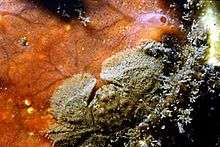Porcellana platycheles
Porcellana platycheles, the broad-clawed porcelain crab, is a species of porcelain crab from the family Porcellanidae. It is found on the coasts of the eastern Atlantic Ocean and in the Mediterranean Sea
| Porcellana platycheles | |
|---|---|
 | |
| Scientific classification | |
| Kingdom: | Animalia |
| Phylum: | Arthropoda |
| Subphylum: | Crustacea |
| Class: | Malacostraca |
| Order: | Decapoda |
| Family: | Porcellanidae |
| Genus: | Porcellana |
| Species: | P. platycheles |
| Binomial name | |
| Porcellana platycheles | |
| Synonyms[2] | |
| |
Description
Porcellana platycheles is a small species of crab which may attain a length of 15 millimetres (0.59 in).[3] This species is a very small and hairy crab which has wide, flattened front claws and two long antennae. It is greenish-brown on its back while the belly is off white.[4] It has a small abdomen which it is tucks under its carapace. The last pair of legs are highly reduced and are normally hidden making the crab appear to have only three pairs of walking legs.[3] The body is flattened too and the legs end in sharp claws which the crabs use to grip onto the underside of the rocks they live below. Although the poelain crabs are called crabs they are in fact more closely related to lobsters and squat lobsters, a relationship hinted at by their long antennae.[5]
Distribution
Porcellana platycheles is distributed from Norway to the Canary Islands and throughout the Mediterranean. In Britain it is widely distributed around all coastlines from Shetland to Scilly.[3]
Habitat and biology
Porcellana platycheles are found beneath rocks and boulders on rocky coasts.[4] It is mainly found where there is mud and gravel in the mid to lower intertidal zones but is occasionally found as low as the shallow subtidal zone.[3] It is a filter-feeding crab, using specially adapted hairs on its mouthparts to filter plankton from the water[4] and it feeds on carrion and other organic debris.[6] This crab needs a habitat with organic matter and has a preference for more sheltered shores, particularly where there has been material deposited among the rocks.[5]
References
- "Porcellana platycheles (Pennant, 1777)". MarBEF Data System. Retrieved January 24, 2009.
- Osawa, Masayuki (2010). "Porcellana Lamarck, 1801". WoRMS. World Register of Marine Species. Retrieved 17 March 2020.
- Ager, O.E.D. (2008). Tyler-Walters H.; Hiscock K. (eds.). "Porcellana platycheles Broad-clawed porcelain crab". Marine Life Information Network: Biology and Sensitivity Key Information Reviews, [on-line]. Plymouth. Marine Biological Association of the United Kingdom. Retrieved 17 March 2020.
- "Porcelain crab". The Wildlife Trusts. Retrieved 17 March 2020.
- "Broad-clawed Porcelain Crab (Porcellana platycheles)". Field Studies Council. Retrieved 17 March 2020.
- Michael Wright & Giles Sparrow (2003). Expert Guide: Marine Life From Tropical Reef Fish to Mighty Sharks. Brown Books. p. 142. ISBN 1-897884-90-7.